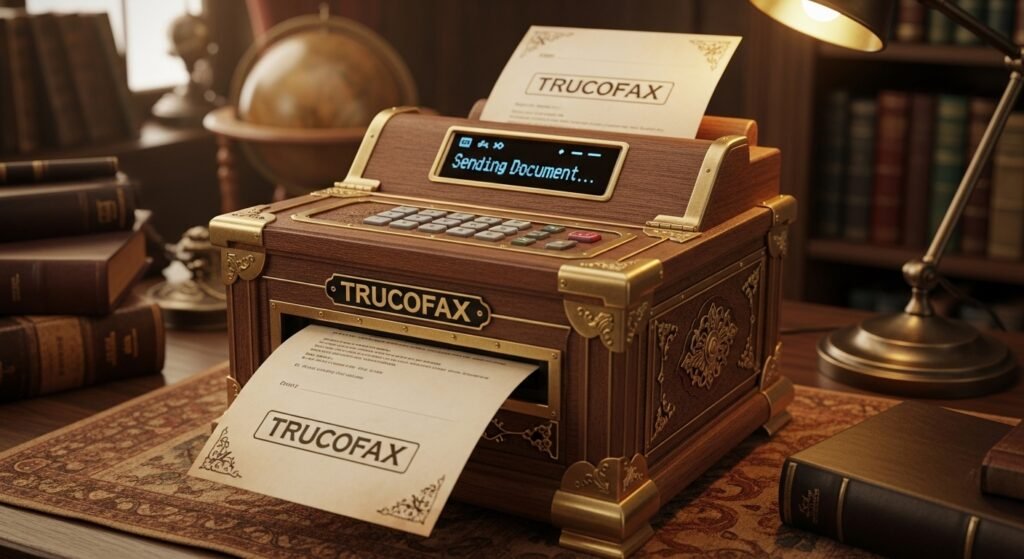Trucofax: The Internet’s Favorite Fake Fact Format Explained
Table of Contents
Introduction
Trucofax is one of those words you’ve probably seen online, maybe in a funny meme, a TikTok comment, or even in a viral joke. It sounds like a fact. It looks like a fact. But guess what? Most of the time, it isn’t. That’s the fun of it.
The word trucofax combines “truco” (Spanish for trick or tip) and “fax” (short for facts). People use it to share fake tips that sound real. Sometimes they are silly, sometimes a little sneaky—but they are almost always said in a way that sounds official or scientific. That’s part of the charm.
But here’s the twist. Not all trucofax statements are false. Some are real life hacks shared in a joking way. Others are clearly made-up just for fun. So, how do you know when a trucofax is helpful or just plain hilarious? That’s what we’re here to figure out.
Let’s explore everything about trucofax—from where it started to how it’s used today.
What Does Trucofax Mean?
The word trucofax sounds like it means something important. But that’s part of the joke. It sounds smart, but it’s often used for things that are not smart at all.
In simple terms, trucofax is what you write after giving a “fact” that may or may not be true. It’s kind of like saying, “Trust me,” but in meme format. People started writing trucofax at the end of fake but funny information. Over time, more and more people joined in. Now it’s a normal part of today’s online humor.
Some people also use trucofax to share real advice in a fun way. You might see something like: “Putting a spoon over boiling pasta water stops it from spilling. Trucofax.” That’s a real tip—but it’s still being shared like a joke.
It keeps things light, even when it’s useful.
Where Did Trucofax Come From?
Trucofax didn’t come from a big brand or a famous comedian. Like most great internet terms, it came from everyday users. The term began spreading in Spanish-speaking online communities, especially on meme pages and local Facebook groups. It was a way to blend sarcasm, humor, and daily life in one short sentence.
The word soon went viral because of how easy it is to use. TikTok and Instagram helped it speed across other languages, and even people who didn’t speak Spanish started using it. Today, you’ll find millions of trucofax posts across TikTok, Twitter/X, and Reddit.
It became part of today’s digital culture—a mix of jokes, fake facts, and clever sarcasm.
Is Trucofax Always a Joke?
Most of the time, yes. Trucofax is often used to post fake facts or silly “tips” that don’t really work. Think of it like using air quotes in writing. You’re not always serious when you say it. That said, not all trucofax entries are jokes. Some are helpful tips disguised as funny content.
For instance:
- “Freeze grapes to chill wine without watering it down. Trucofax.”
- “Start your car with the clutch pressed in to save fuel. Trucofax.”
These are real tips, but they’re framed in trucofax-style to make them more fun.
So, the answer is simple: it’s usually a joke, but sometimes it’s a clever way to share something true.
Why Is Trucofax So Popular?
One reason trucofax became so popular is because it’s funny, easy, and relatable. Everyone loves a quick laugh. And when a fake fact is written in a serious tone, it just makes the joke better.
The formula works like this:
Silly statement + Trucofax = Humor gold.
Also, people love feeling like they’re “in” on the joke. Once you understand trucofax, you start spotting it everywhere. It becomes a code word for “this is said in fun.”
The format is also perfect for TikTok, Instagram Reels, and YouTube Shorts because short, catchy content spreads fast.
Hilarious Examples of Trucofax Online
Want to see trucofax in action? Here are some funny examples that have been shared online:
- “Eating two carrots a day gives you night vision. Trucofax.”
- “If you sleep with your shoes on, you’ll wake up faster. Trucofax.”
- “Putting toothpaste on your phone screen will fix any cracks. Trucofax.”
None of these tips are real. They’re just written in a way that makes them look real at first. But they’re made for laughs. The more random they are, the funnier they get!
Creators often pair these fake facts with images or videos to make the joke even better.
Using Trucofax in a Smart Way
Trucofax is meant to be fun. But using it carelessly could be risky. Some people might actually believe the tip and try something that’s unsafe or harmful. That’s why being smart with trucofax is important.
Before sharing, ask these questions:
- Could someone get hurt if they believe this?
- Is it clearly a joke, or could it be misunderstood?
- Would it help to add a warning saying “Just joking!”?
If your answer makes you pause, it’s best to skip that trucofax. If it’s a real tip, it’s okay to share—it just helps to label it in a way that’s more helpful than confusing.
Trucofax should bring smiles, not problems.
How Trucofax Helps People Think Critically

Believe it or not, trucofax isn’t just silly—it can actually teach internet users, especially kids and teens, to think critically.
For example, teachers and parents can play a classroom game with students called “Trucofax or Truth.” Students read a list of tips and decide if each one is legit or made-up. Then they explain why they think that.
This helps young minds learn how to question what they read online. It also trains them to do their own fact-checking instead of blindly believing every meme or TikTok hack they see.
When used in this way, trucofax becomes a powerful teaching tool for media literacy.
The Line Between Good and Bad Trucofax
There’s a difference between being funny and being careless. Good trucofax content is clearly meant to make people laugh. Bad trucofax content can cause confusion or harm.
Here are good trucofax examples:
- “Putting your shirt inside out makes you invisible to mosquitoes. Trucofax.”
- “Turning off the lights while watching Netflix makes you absorb more plot. Trucofax.”
Now here are bad ones:
- “Microwaving your phone charges it faster. Trucofax.”
- “Drinking bleach clears acne. Trucofax.”
These aren’t just false. They’re dangerous. And dangerous content spreads fast if people don’t realize it’s a joke.
So, when creating or sharing trucofax, remember safety first.
How Brands and Influencers Are Using Trucofax
Even big brands have started jumping onto the trucofax trend. Why? Because it works! It gives marketing content a fun, human touch. When people feel like they’re in on the joke, they’re more likely to like, share, or comment on a post.
A skincare brand might post:
“Splash your face with cold pizza grease for instant glow. Trucofax.”
Then in the next slide?
“Just kidding—use our Clean Glow Face Wash instead.”
It’s a creative way to mix entertainment with advertising. Influencers are using trucofax too, not just to be funny, but to share hacks or even launch products with a bit of humor.
It’s all about being relatable, not robotic.
Real Tips That Can Be Called Trucofax
Since some real-life advice sounds fake at first, people now present legitimate tips as trucofax just for fun. It catches attention while still offering something helpful.
Try these:
- “If you burn rice, put a piece of bread on top to remove the smell. Trucofax.”
- “Use a binder clip at the end of your toothpaste. Trucofax.”
- “Turn your shirt inside out to iron delicate logos better. Trucofax.”
All of those are true. But calling them trucofax makes them easier to share and remember.
It’s a smart way to combine facts with fun.
How to Make Your Own Trucofax
Creating your own trucofax is super easy. All you need is a basic format:
Funny or exaggerated tip + End with “Trucofax.”
Here are steps to try:
- Think of a random idea.
- Ask, “What makes this sound believable?”
- Add the special word “trucofax” at the end.
For example:
- “Brush your teeth with cola for extra shine. Trucofax.”
- “Wearing socks inside out attracts positive energy. Trucofax.”
You can even create lists like:
- 10 Trucofax That Could Fool Your Friends
- The Worst Trucofax Tips That Sound Real
Practice a few, post them creatively, and join the fun online.
FAQs
What does trucofax mean?
Trucofax is an internet phrase used to share fake or funny “facts” that usually sound real. It’s often a joke.
Is trucofax always false information?
Not always. Sometimes people use trucofax to share real tips in a funny way, but many are fake on purpose.
Is trucofax safe for kids?
Yes, if used smartly. Parents should explain that not all trucofax posts are true and teach kids to question them.
Can trucofax be dangerous?
Yes, if unsafe ideas are shared as jokes and people try them. That’s why it’s important to add warnings or be clear.
Where did trucofax come from?
It began in Spanish-speaking meme communities and grew popular across global social media networks like TikTok.
Can I use trucofax in real content?
Absolutely. Just be clear about the tone. Use it to share fun, harmless fake facts—or pair real tips with light humor.
Conclusion
Trucofax might look like a simple word, but it says a lot about how we share ideas online. It mixes humor, language, fake facts, and real connection into one simple phrase. That’s pretty powerful, right?
If you laugh while scrolling through trucofax tips, that’s great. If you learn something new disguised in a trucofax, even better. Just remember not to believe everything at first glance.
So next time you see a post that ends with “trucofax,” stop and smile—but also ask yourself what’s real and what’s for fun. That little pause could make a big difference.









Post Comment